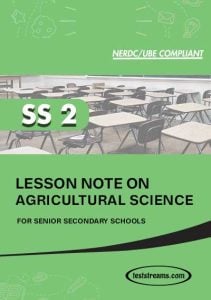This AGRICULTURAL SCIENCE Lesson Note was pulled from our book (Lesson Note on AGRICULTURAL SCIENCE for SS2 MS-WORD); Compiled to serve as reference material to help teachers draw out their lesson plan easier, saving you valuable time to focus on the core job of teaching.
This AGRICULTURAL SCIENCE Lesson Note Covers The Following Topics
- Soil Composition and Properties
- Farm Structures and Buildings
- Siting of Farm and Layout of Farm Structure
- Farm machines
- Crop Propagation
- Cultural Practices
- Planting Operations
- Post Planting Operations and Harvesting
- Simple Experiment on Porosity, Percolation, and Capillarity of the Soil
- Soil Fertility
- Feeds and Feeding
- Farming Systems
- Cropping Systems
- Fishery
- Farm Animal Husbandry
- Management Requirement in Animal Husbandry
- Soil Conservation
- Farm
- Disease-Causing Organisms
- Storage of Farm Produce
- Crop Plant Diseases
- Development of Agriculture in Nigeria
- Employment Opportunities in Agriculture
- Forest and Forest Uses
- Farm Animal Diseases
- Preservation of Farm Produce for
- Marketing
- Husbandry of Selected Crops
Sample note
Week 1
Topic: Soil Composition And Properties
Contents:
What is Soil?
Soil Composition
Importance of Soil
- What is Soil?
Soil is the loose or thin layer on the surface of the earth on which the plants and animals lives. It is the loose combination of inorganic and organic materials. Soil is the upper layer of earth in which plants grow, a black or dark brown material typically consisting of a mixture of organic remains, clay, and rock particles.
Soil is considered to be the “skin of the earth” with interfaces between the lithosphere, hydrosphere, atmosphere of Earth, and biosphere. Soil consists of a solid phase (minerals and organic matter) as well as a porous phase that holds gases and water. Accordingly, soils are often treated as a three-state system.
Soil is the end product of the influence of the climate, relief (elevation, orientation, and slope of terrain), organisms, and parent materials (original minerals) interacting over time. Soil continually undergoes development by way of numerous physical, chemical and biological processes, which include weathering with associated erosion.
Physical Properties of the Soil
- Texture:Texture refers to the relative proportions of particles of various sizes such as sand, silt and clay in the soil. Properties that are influenced by soil texture, include porosity, permeability, infiltration, shrink-swell rate, water-holding capacity, and susceptibility to erosion.
- Structure: The term texture is used in reference to the size of individual soil particles but when the arrangement of the particles is considered the term structure is used. Structure refers to the aggregation of primary soil particles (sand, silt and clay) into compound particles or cluster of primary particles which are separated by the adjoining aggregates by surfaces of weakness. Structure modifies the effect of texture in regard to moisture and air relationships, availability of nutrients, action of microorganisms and root growth. The clumping of the soil textural components of sand, silt and clay causes aggregates to form and the further association of those aggregates into larger units creates soil structures called pedoliths or peds. The adhesion of the soil textural components by organic substances, iron oxides, carbonates, clays, and silica, and the breakage of those aggregates from expansion-contraction, caused by freezing-thawing and wetting-drying cycles, shape soil into distinct geometric forms. Classes of Soil Structure includes:
- ; >100mm prism-like.
- Grades: Is a measure of the degree ofdevelopment or cementation within the peds that results in their strength and stability.
- Weak: Weak cementation allows peds to fall apart into the three textural constituents, sand, silt and clay.
- Moderate: Peds are not distinct in undisturbed soil but when removed they break into aggregates, some broken aggregates and little un-aggregated material. This is considered ideal.
- Strong: Peds are distinct before removed from the profile and do not break apart easily.
- Structure-less: Soil is entirely cemented together in one great mass such as slabs of clay or no cementation at all such as with sand.
- Grades: Is a measure of the degree ofdevelopment or cementation within the peds that results in their strength and stability.
- Density: Density is the weight per unit volume of an object. Particle density is equal to the mass of solid particles divided by the volume of solid particles – it is the density of only the mineral particles that make up a soil; i.e., it excludes pore space and organic material.
- Consistency: This is the resistance of a soil to deformation or rupture and is determined by the cohesive and adhesive properties of the soil mass. Consistency is the ability of soil to stick to itself or to other objects (cohesion and adhesion respectively) and its ability to resist deformation and rupture. This is a term used to designate the manifestation of the cohesive and adhesive properties of soil at various moisture contents. A knowledge of the consistence of the soil is important in tillage operations, traffic and pond constructions. Consistence gives also an indication of the soil texture. Consistence is described for three moisture levels:
- Wet soil– non sticky, slightly sticky, sticky, very sticky; non plastic, slightly plastic, plastic and very plastic.
- Moist soil– loose, very friable, friable, firm, very firm, extremely firm.
- Dry soil– loose, soft, slightly hard, hard, very hard, extremely hard.
- Porosity: Particle density can be determined using specific gravity bottle technique and bulk density by taking soil core samples of known volume in the field and determining the even dry weight (Blacket al., 1965a). Pore space is that part of the bulk volume of soil that is not occupied by either mineral or organic matter but is open space occupied by either gases or water. Ideally, the total pore space should be 50% of the soil volume. The gas space is needed to supply oxygen to organisms decomposing organic matter, humus, and plant roots. Pore space also allows the movement and storage of water and dissolved nutrients. There are four categories of pores:
- Very fine pores: < 2µm
- Fine pores: 2-20µm
- Medium pores: 20-200µm
- Coarse pores: 200µm-0.2 mm
- Temperature: Soil temperature depends on the ratio of the energy absorbed to that lost. Soil has a temperature range between 20 to 60° Soil temperature regulates seed germination, plant and root growth and the availability of nutrients.
- Colour: Soil colour gives an indication of the various processes going-on in the soil as well as the type of minerals in the soil. For example, the red colour in the soil is due to the abundance of iron oxide under oxidized conditions (well-drainage) in the soil; dark colour is generally due to the accumulation of highly decayed organic matter; yellow colour is due to hydrated iron oxides and hydroxide; black nodules are due to manganese oxides; mottling and gleying are associated with poor drainage and/or high water table

Get the complete Lesson Note with more content at very affordable price. Lesson Note on AGRICULTURE for SS2 MS-WORD- PDF
![]()




